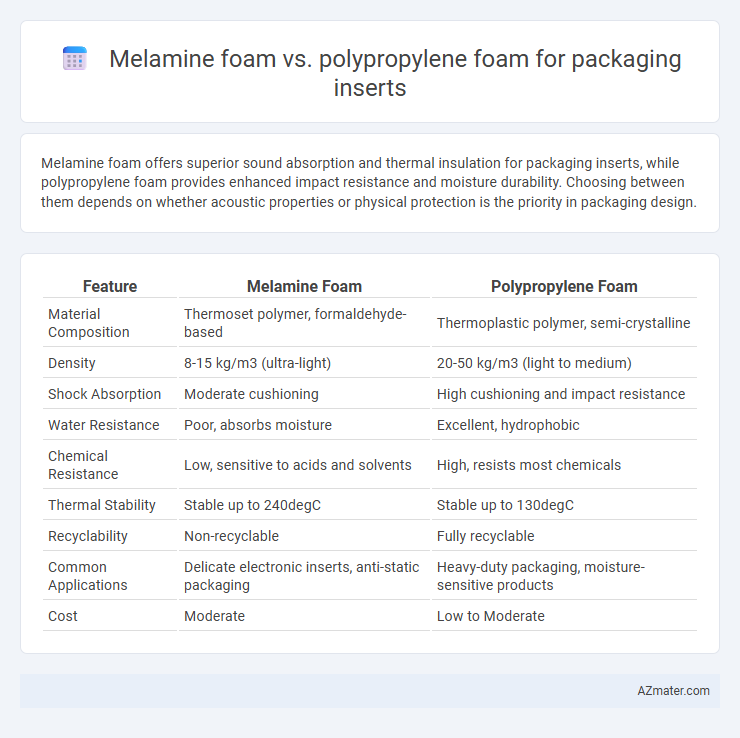Melamine foam offers superior sound absorption and thermal insulation for packaging inserts, while polypropylene foam provides enhanced impact resistance and moisture durability. Choosing between them depends on whether acoustic properties or physical protection is the priority in packaging design.
Table of Comparison
| Feature | Melamine Foam | Polypropylene Foam |
|---|---|---|
| Material Composition | Thermoset polymer, formaldehyde-based | Thermoplastic polymer, semi-crystalline |
| Density | 8-15 kg/m3 (ultra-light) | 20-50 kg/m3 (light to medium) |
| Shock Absorption | Moderate cushioning | High cushioning and impact resistance |
| Water Resistance | Poor, absorbs moisture | Excellent, hydrophobic |
| Chemical Resistance | Low, sensitive to acids and solvents | High, resists most chemicals |
| Thermal Stability | Stable up to 240degC | Stable up to 130degC |
| Recyclability | Non-recyclable | Fully recyclable |
| Common Applications | Delicate electronic inserts, anti-static packaging | Heavy-duty packaging, moisture-sensitive products |
| Cost | Moderate | Low to Moderate |
Introduction to Packaging Foam Inserts
Melamine foam and polypropylene foam are widely used materials for packaging foam inserts, offering distinct advantages based on their chemical properties and application scenarios. Melamine foam features a highly open-cell structure, providing excellent cushioning, sound absorption, and heat resistance, making it ideal for delicate or electronic items. Polypropylene foam, characterized by its closed-cell structure, delivers superior impact resistance, moisture resistance, and durability, which is beneficial for heavy-duty packaging or reusable inserts.
Overview of Melamine Foam
Melamine foam is a lightweight, open-cell material widely used in packaging inserts for its excellent shock absorption, thermal insulation, and soundproofing properties. Its high porosity and thermal stability make it ideal for protecting sensitive electronics and fragile items during shipping. Compared to polypropylene foam, melamine foam offers superior fire resistance and a smoother surface finish, enhancing both safety and aesthetic appeal in packaging applications.
Overview of Polypropylene Foam
Polypropylene foam is a lightweight, durable material widely used for packaging inserts due to its excellent impact resistance and cushioning properties. Its closed-cell structure provides superior moisture resistance and thermal insulation compared to melamine foam, making it ideal for protecting sensitive items during transit. Polypropylene foam is also environmentally friendly, being recyclable and offering a cost-effective solution for sustainable packaging needs.
Key Physical Properties: Melamine vs Polypropylene
Melamine foam exhibits a unique combination of low density, high thermal resistance, and excellent sound absorption, making it ideal for delicate packaging inserts that require protection from heat and vibration. Polypropylene foam offers superior impact resistance, lightweight durability, and hydrophobic properties, which help prevent moisture damage and provide cushioning in packaging applications. When selecting between melamine and polypropylene foam, consider melamine's open-cell structure for breathability and flame retardance versus polypropylene's closed-cell structure for enhanced water resistance and compressive strength.
Cushioning Performance Comparison
Melamine foam offers superior cushioning performance for packaging inserts due to its open-cell structure, which provides excellent shock absorption and vibration dampening, making it ideal for protecting fragile items. Polypropylene foam, while lightweight and resistant to moisture, has a closed-cell structure that delivers moderate cushioning but less impact absorption compared to melamine foam. The higher resilience and energy absorption capacity of melamine foam make it the preferred choice for applications requiring advanced protection against mechanical stress.
Durability and Longevity Analysis
Melamine foam offers exceptional durability with its high resistance to compression and excellent noise absorption, making it ideal for delicate packaging inserts requiring long-term protection. Polypropylene foam, known for its chemical resistance and resilience to moisture, provides superior longevity in environments exposed to humidity and frequent handling. Both foams maintain structural integrity over time, but polypropylene's enhanced resistance to environmental factors often translates to a longer-lasting packaging solution in variable conditions.
Chemical Resistance and Safety
Melamine foam offers superior chemical resistance against acids, bases, and solvents, making it highly durable for packaging inserts exposed to harsh environments. Polypropylene foam is chemically inert and resists many common chemicals, but may degrade when exposed to strong oxidizers or UV light over time. Both materials are non-toxic and safe for direct contact with consumer goods, but melamine foam's higher resistance to chemical breakdown ensures enhanced safety in packaging applications involving aggressive substances.
Environmental Impact and Recyclability
Melamine foam is a lightweight, durable material commonly used in packaging inserts but poses challenges for recycling due to its thermoset structure, which cannot be remelted or reshaped, leading to limited environmental sustainability. Polypropylene foam, by contrast, is a thermoplastic that offers greater recyclability and lower environmental impact, as it can be melted down and reused multiple times, reducing landfill waste. The choice between melamine and polypropylene foam hinges on balancing functional packaging protection with long-term ecological benefits, favoring polypropylene for circular economy initiatives.
Cost Effectiveness for Packaging Applications
Melamine foam offers excellent cushioning and sound absorption but tends to be higher in cost compared to polypropylene foam, making it less budget-friendly for large-scale packaging applications. Polypropylene foam provides a cost-effective solution with good impact resistance and lightweight properties, significantly reducing overall packaging expenses. For companies prioritizing cost efficiency without compromising basic protective qualities, polypropylene foam is often the preferred choice for packaging inserts.
Choosing the Right Foam for Your Packaging Needs
Melamine foam offers exceptional sound absorption and fire resistance, making it ideal for packaging fragile electronics or instruments requiring vibration dampening and thermal protection. Polypropylene foam provides superior impact resistance, lightweight cushioning, and moisture resistance, which suits packaging for automotive parts and heavier goods needing shock absorption. Selecting the right foam depends on balancing factors such as product fragility, weight, moisture exposure, and budget constraints to ensure optimal protection during shipping and handling.

Infographic: Melamine foam vs Polypropylene foam for Packaging insert
 azmater.com
azmater.com